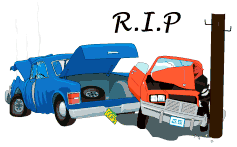| End of Life Vehicle Directive |
|

|
|
In 1997 the European Union as part of it's ongoing environmental strategy produced a directive aimed at making improving the "re-cycle-ability" of cars. The "end of life vehicle" directive states that "the materials used in the car manufacture should no longer be a source of pollution and a waste of resources." The European directive is intended to make vehicle dismantling and recycling more environmentally friendly and sets clear quantified targets for reuse, recycling and recovery of vehicles and their components. The target of the proposal is to reach a level where by the year 2005 85% of the vehicles' weight should be reused and/or recovered, and 80% reused and/or recycled. In addition by 2015 the level should be 95% reused and/or recovered, and 85% reused and/or recycled. Although this might seem a tall order car manufacturers world-wide have been making some efforts to achieve better re-cycle-ability and in particular companies such as VW, BMW, Toyota and Nissan have taken up the challenge. An important element of the directive is that it puts the responsibility of disposal firmly at the feet of the car manufactures. It applies the important principle of producers' responsibility by "establishing that collection and recycling of end of life vehicles shall not be a burden of public authorities but shall be the responsibility of the automotive sector's economic operators". It is the responsibility of producers to ensure that vehicles are designed and manufactured in such a way as to allow the rates of re-use, recycling and recovery as set out in the directive. The Problem Discarded vehicles today result in 8 to 9 million tonnes of waste each year in the European Union (EU). Some 25% of the vehicles weight (the so called "shredding residues") today is generally landfilled, which can lead to contamination of both soil and groundwater. These residues contain significant quantities of hazardous substances such as heavy metals, polychlorinated biphenyl's (PCB), chlorofluorocarbon (CFCs), organic substances etc. This kind of waste amounts to about 2 million tonnes of waste per year and represents up to 10% of the total amount of hazardous waste generated yearly in the EU and amounts to 60% of the total shredder waste. In particular the heavy metals such as lead, mercury, cadmium and hexavalent chromium contained in vehicles is to be prevented from entering the shredding process and will not be incinerated or landfilled either. Methods must be developed to re-cycle these materials or they will be phased out of new vehicles. The concept is to put pressure on vehicle manufacturers to incorporate disposal into vehicle design. It will not be sufficient to provide alternative disposal methods but to reduce the amount of materials in vehicles, which requires disposal at all. Currently vehicles are often exported to be scrapped in countries where disposal prices and environmental requirements are lower and this does not support the concept of sustainability which many countries signed up to at the Rio Earth summit. |